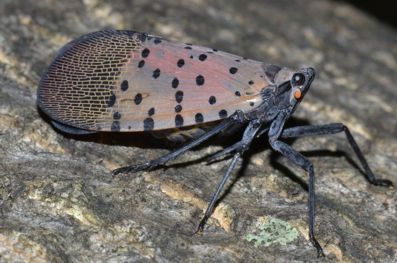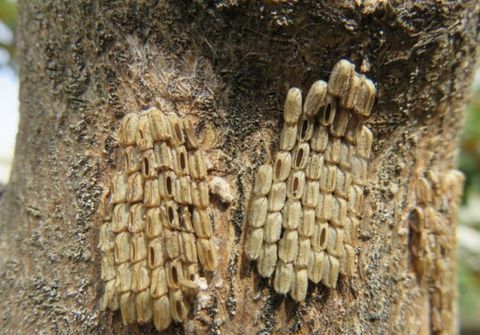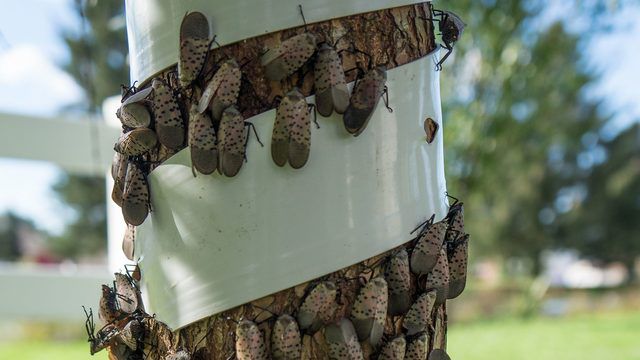|
BE ON THE LOOKOUT FOR . . .
 The Spotted Lanternfly, Lycorma delicatula (White), an invasive plant hopper, has been discovered in Berks County, Pennsylvania. It is native to China, India, Vietnam, and introduced to Korea where it has become a major pest. This insect has the potential to greatly impact the grape, hops and logging industries. Early detection is vital for the protection of Pennsylvania businesses and agriculture. The Spotted Lanternfly, Lycorma delicatula (White), an invasive plant hopper, has been discovered in Berks County, Pennsylvania. It is native to China, India, Vietnam, and introduced to Korea where it has become a major pest. This insect has the potential to greatly impact the grape, hops and logging industries. Early detection is vital for the protection of Pennsylvania businesses and agriculture.
Identification:
The Spotted Lanternfly adult is approximately 1” long and 1/2” wide at rest. The forewing is grey with black spots and the wings tips are reticulated black blocks outlined in grey. The hind wings have contrasting patches of red and black with a white band. The legs and head are black; the abdomen is yellow with broad black bands. Immature stages are black with white spots, and develop red patches as they grow.
 Signs & Symptoms: Signs & Symptoms:
Trees, such as tree of heaven and willow, will develop weeping wounds. These wounds will leave a greyish or black trail along the trunk. This sap will attract other insects to feed, notably wasps and ants. In late fall, adults will lay egg masses on host trees and nearby smooth surfaces like stone, outdoor furniture, vehicles, and structures. Newly laid egg masses have a grey mud-like covering which can take on a dry cracked appearance over time. Old egg masses appear as rows of 30-50 brownish seed-like deposits in 4-7 columns on the trunk, roughly an inch long.
What to do?
The Spotted Lanternfly is spreading fast. People who have never seen the nymphs are finding them all over their yard. Hopefully before they eat every tree and bush in sight! If you see egg masses, scrape them off, double bag them and throw them away. You can also place the eggs into alcohol or hand sanitizer to kill them.
Here is advice gathered from professional sources plus some very useful and practical advice from folks who have been living with this prolific and destructive bug for a couple of years now.
1. Most folks prefer the sticky paper trap. The nymphs preferred method of locomotion is crawling, so putting a band of sticky tape in a circle around a tree, rosebush stem, or deck post- wherever you find the nymphs - will catch a lot of them. They are attracted to peppermint and spearmint. So, these essential oils will entice even more pests, but they aren’t necessary. Please monitor these traps, as they can catch beneficial insects, butterflies, birds and even squirrels.
 Rings of inside-out duct tape instead of the sticky paper Rings of inside-out duct tape instead of the sticky paper- Smaller sticky fly paper for around bush stems and other places too small for the large flypaper
- Cut a small piece off and tab the line of them off grapevines. They don't see it coming, and you can catch many.
- Olive oil and a gentle, warm bath with a little Dawn works to remove a bird from the tape. If they appear injured, take them to a wildlife center. One person reported that Vaseline works as well as glue to trap the bugs, but doesn't hurt birds, so try smearing Vaseline on tape around a plant and see!
2 Apparently, lanternflies love lemon-scented Mr. Clean, but it does not attract other bugs, so it can be used as a lure. Put out a shallow pan of water with a little lemon scented Mr. Clean in it, and they should dive into the water and die. Here is another great method - take a funnel large enough for the nymphs to crawl through and place it in a wide mouthed Gatorade bottle filled with water and a little Lemon Scented Mr. Clean! It helps if the funnel is silicone, because they can't climb back out. The nymphs will be attracted to the Mr. Clean and jump in the bottle and die. Be sure to carefully dispose of the water with Mr. Clean in it, by pouring it down a sink or drain that goes into a water treatment system. Don't pour it on the ground!
3. Water! One woman tried putting out bowls of water after seeing so many dead lanternflies in her pool, and it worked! She uses all kinds of bowls, plus aluminum foil lasagna pans. She gets many dead lanternflies every day.
Water again! One woman reports: I actually pressure washed my maple last year to get them off. The tree was fine after, the lanternflies, not so fine.
4. If the lanternflies are on weeds you don't want around anyway (they love wild grape), spray with vinegar. They die instantly, and you might get rid of the weed, too.
5. Vacuum them into a shop vac with warm soapy water in the bucket and they will die.
6. Pour warm soapy water over them. They die instantly. Soap is harmful to plants, so this method works best on decks and other non-plant surfaces. Soap breaks down the outer protective layer on plants and can make them more susceptible to disease.
7. Spraying them with Lysol spray cleaner, 70% isopropyl alcohol, and Windex will kill them
If you have are having a problem with these pests and have found a better way
of controlling or eliminating them,
please let us know so we can share the information with others.
For more information, go to:
http://www.agriculture.pa.gov/Plants_Land_Water/PlantIndustry/Entomology/spotted_lanternfly/Pages/default.aspx
|